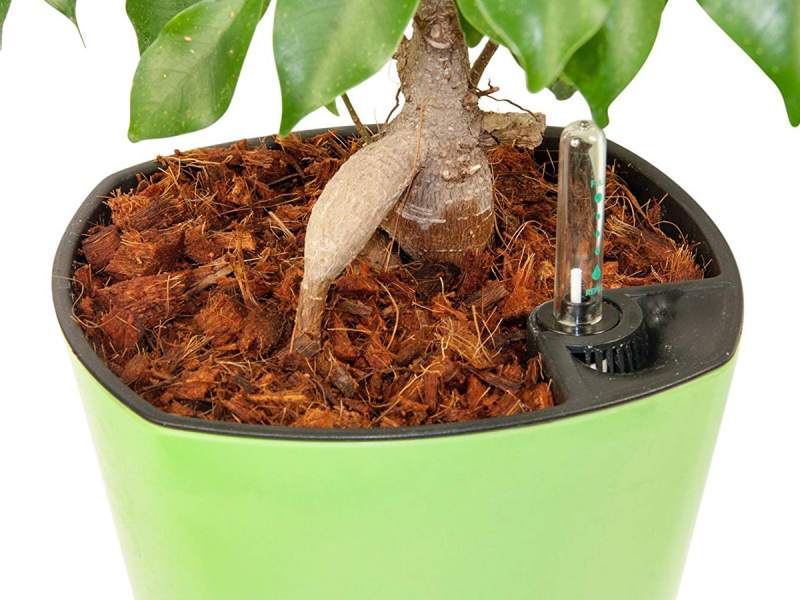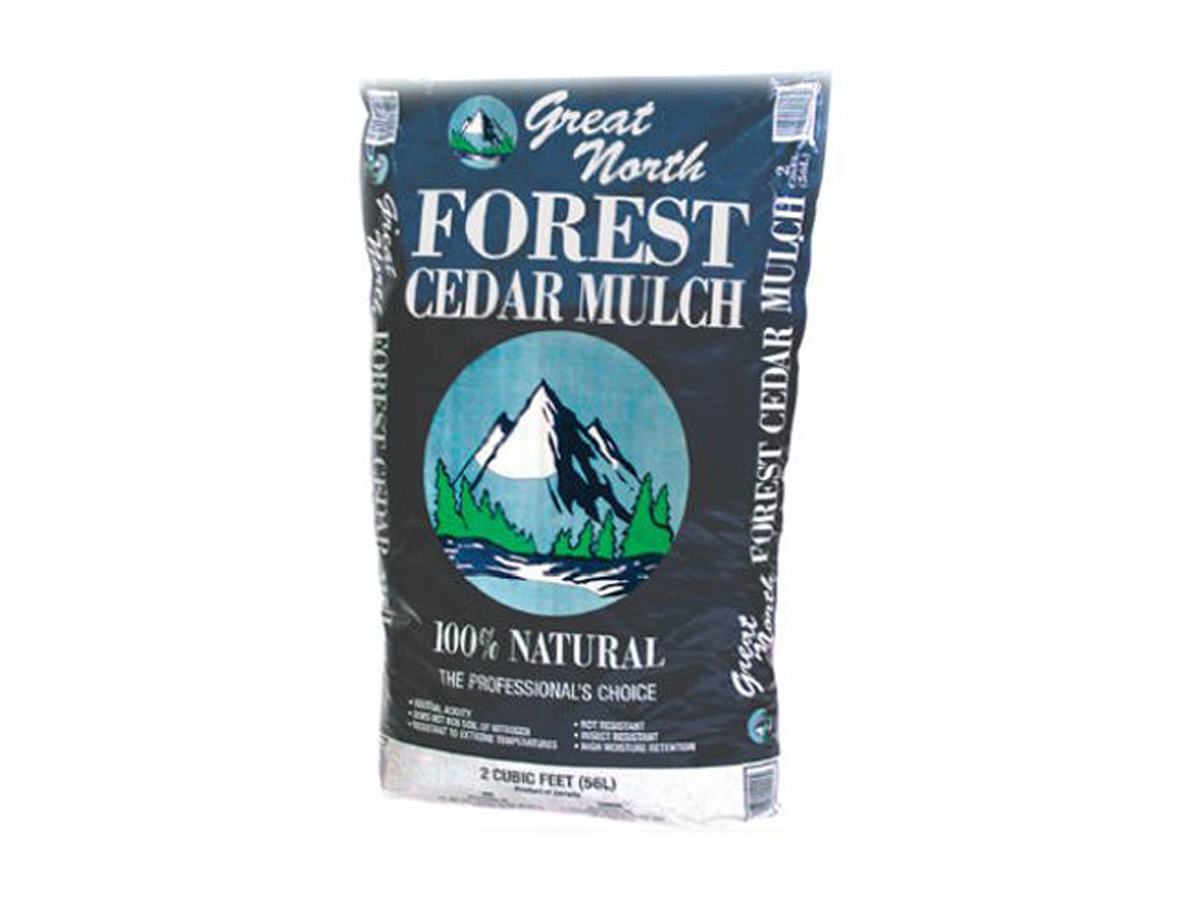- Mulch helps preserve soil moisture, block weeds, and can enrich and improve the soil.
- Selecting the best type of mulch can save money, protect natural resources, and give you the gardening results you desire.
- For a long-lasting, insect-resistant organic garden mulch, Great North Forest Cedar Mulch is our pick.
When you see a photo of a garden that you love, your eye is drawn to the hardscape of walls and paths and the natural beauty of the flowers, shrubs, and trees. You probably don’t notice the mulch, but it’s there. The unified look and the lack of unsightly weeds are your first clues that the gardener knows the benefits of mulching to conserve moisture, help control weeds, and add nutrients to the soil for healthier plants.
There are nearly as many varieties of mulch as there are plants. Natural mulches include tree bark, sawdust, wood chips, chopped autumn leaves, pine straw, oyster shells, cocoa bean shells, crushed and natural stone, and even newsprint. Recycled rubber, plastic pellets, and plastic sheeting are used to create inorganic mulches. The key to the successful use of mulch is knowing the best type of mulch for your garden site and growing zone and using it properly.
Your local county extension office can help you determine the best type of mulch for improving your garden and giving you the aesthetic you desire. As a farmer’s daughter, I have a good understanding, but I’ve learned so much from the horticulture specialists and county agents I worked with at Clemson University Extension. They help community members with gardening problems and teach them to become Master Gardeners.
Whatever type of mulch you use, be sure to use enough. A thin layer may look good in the short term but it won’t block the weeds or do much good to hold moisture in the soil. You need at least two to four inches of mulch to make an impact.
As you spread the mulch, remember to keep it several inches away from the stem of the plant or trunk of the tree or shrub to prevent rot from too much moisture. Plants need moisture in the roots, not next to the stem.
Most gardening centers and home improvement stores can help you determine how much mulch you need. If you want to figure it out yourself, use a "mulch calculator" like this one from Home Depot so you can budget for enough mulch to make an impact.
If you like to prevent weeds, protect plant roots, lower your garden watering bill, and maintain an attractive look to your planted areas, you'll need mulch. We've tested these five garden mulches for durability, sun-fading, ease of use, and, of course, price.
Here are the best mulches:
- Best organic mulch: Great North Forest Cedar Mulch
- Best inorganic mulch: Plow and Hearth Perma Mulch Border
- Best mulch for potted plants: Window Garden Fiber Mulch
- Best mulch for freshly seeded lawns: EZ Straw Seeding Mulch with Tack
The best organic mulch
Long-lasting and decay-resistant, Great North Forest Cedar Mulch is also a natural pest repellent.
Cedar mulch is usually one of the more expensive choices but it is also one of the best choices because unlike some other types of organic mulch, Great North Forest Cedar Mulch resists decay and lasts longer in the garden. Made of cedar tree bark and wood chips without any fillers, it won't need to be replenished as frequently as other types of mulch.
This mulch is not dyed and adds a lovely golden yellow with a hint of red to the garden bed. The cedar resins emit a "pine scent" which is pleasant to our noses but not to many types of insects that can damage plants. The one downside to cedar mulch is that it can draw nitrogen from the soil. This shouldn't be a problem if you routinely fertilize your garden.
I love this mulch because it is heavy enough to block weed growth around established trees and shrubs without floating away during heavy rains. And, because it is slow to decay, I don't have to reapply mulch as often as I do when using leaf compost or pine straw. I would rather pay a bit extra and know that I am getting true cedar (not a substitute) and not have to do double the labor to replace it every season!
Pros: 100% pure cedar bark and wood chips, decay-resistant, repels insects, stands up to heavy rains
Cons: More expensive than other types of mulch, can reduce nitrogen levels in the soil
The best inorganic mulch

Your garden beds will have perfectly neat edges with Plow and Hearth Perma Mulch Border.
I'll admit, I'm not a big fan of inorganic mulches. Somehow putting rubber or plastic pellets around natural vegetation just doesn't seem right. However, I do love a neat edge to a garden bed and nothing does that better than Plow and Hearth Perma Mulch Border.
Made from recycled, shredded rubber tires, the border is 4.5 inches wide and comes in a 10-foot roll. The rubber shreds are bonded together and thick enough to prevent weeds from receiving the sunlight they need to grow but permeable enough to allow water to flow into the soil. To install, all you need to do is roll it out and cut to the desired length with scissors. It is heavy enough to stay in place during windy days.
I use it in the vegetable, annual, and perennial beds where I surround the tender plants with compost. The black rubber blends in and helps keep the lighter-weight compost in place. It keeps the edges neat and prevents weed growth. I've had it down for three seasons and it is still going strong. I even use it to hold black plastic in place during winter months.
I just wish they would offer the same product in brown for my other beds.
Pros: Blocks weed growth, easy to install, durable
Cons: Only available in black, must use landscape staples to form curves, if needed, to edge a garden bed
The best mulch for potted plants

Window Garden Fiber Mulch provides your potted plants with the same benefits of mulch in your garden.
Now that you know the benefits of mulching plants in your garden, don't you want to extend the love to your indoor and outdoor potted plants? Window Garden Fiber Mulch will make your green thumb efforts even better.
Just as garden mulch helps the soil retain moisture and blocks the growth of unsightly weeds, the coconut husks and fibers of Window Garden Mulch do the same for potted plants. The mulch not only gives a natural, finished look around the roots of the plant, but it also helps hold soil in place and reduces the need for watering as frequently.
Gather the kids around when it arrives because they will love to see the mulch grow before their eyes. You'll receive a seven-inch square tile and a large heavy-duty plastic bag. Pop the tile in the bag and add water and it will grow to five-quarts of mulch. You don't need to use it all right away and can use the bag for storage.
I have the mulch on every indoor and outdoor potted plant. My plants look great and there is no compaction of the soil or splashing if I happen to water too aggressively. I particularly love it for surrounding the roots of my orchids and air plants that should not be planted in heavy soil.
Pros: Attractive, porous mulch, reduces moisture loss from potted plants, fun to reconstitute
Cons: Can blow away if soil level is too high in the planted container
The best mulch for freshly seeded lawns

Your hard work reseeding a lawn won't be for naught if you use EZ Straw Seeding Mulch with Tack to keep the seeds in place.
Lawns get bare spots - kids wear out the grass playing, insects invade, droughts happen. When it's time to reseed those areas, EZ Straw Seeding Mulch with Tack will help you watch the grass grow.
Seeding or reseeding lawns takes a great deal of work. The soil must be tilled, seeds sown, and those seeds must be watered and kept in place until roots form. Wind, excessive water, birds, and squirrels are all ready to snatch the seeds out of the ground. That's why you need to protect the seeds.
This mulch is natural straw that has an applied bonding agent that holds it together to form a mat over the freshly planted seeds. I use it for both lawn repair and to protect flower and vegetable seeds that I sow directly in the soil. The straw is biodegradable so it can stay in place after the seeds sprout.
This may not be the most beautiful mulch you've ever seen, but it is one of the most helpful in the garden.
Pros: Protects freshly seeded areas, biodegradable, covers 500-square-feet, comes in a heavy-duty bag for easy storage.
Cons: Does not blend into the garden.
